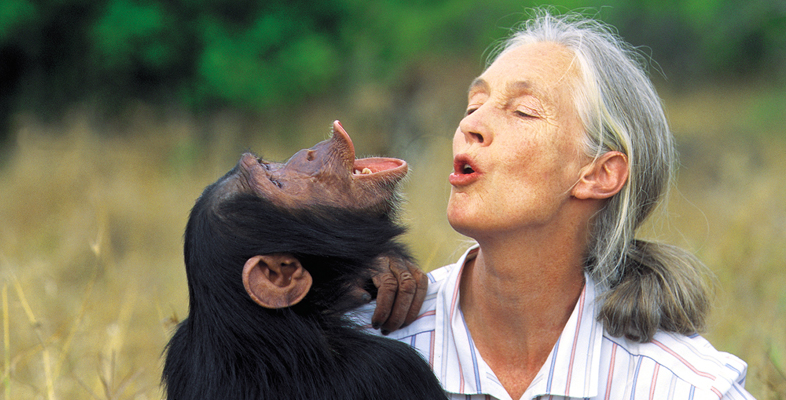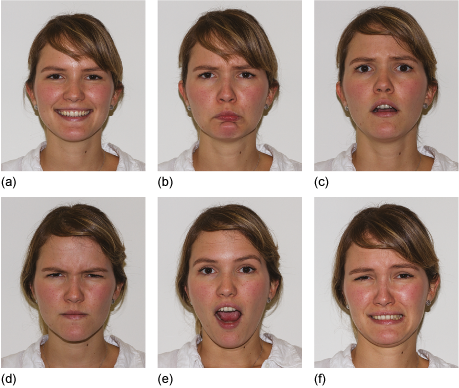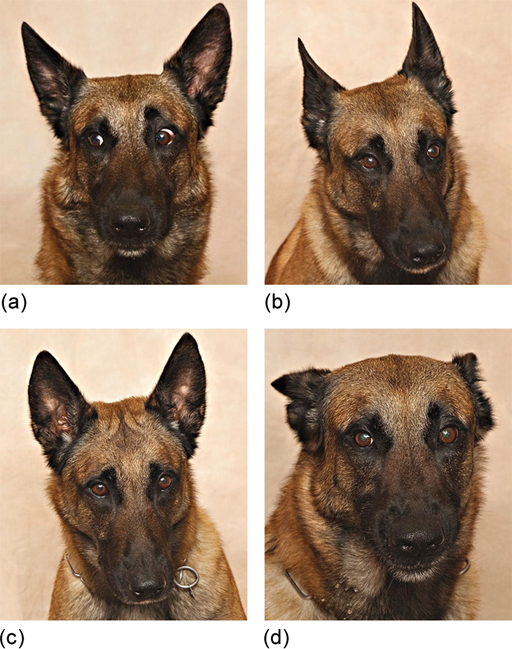3.2 Emotions in different species: humans and dogs
Psychologists have long distinguished between ‘primary’ and ‘secondary’ emotions:
- Primary emotions can be defined as the most basic emotions, generated by some external stimulus (e.g. fear in response to seeing a predator); and as being the initial response to something, felt before, and without, thinking.
- Secondary emotions are more complex, sometimes made up of a combination of primary emotions. They are not a direct and immediate response to a stimulus, and typically require a cognitive element. For example, while ‘sadness’ might be the primary emotion felt, ‘melancholy’ or ‘regret’ might be secondary emotions that are felt when a ‘sad’ event is thought about.
On this course, you will only consider primary emotions, as there is more compelling evidence that animals might experience these.
In humans, six primary emotions are associated with particular involuntary facial expressions, which were first identified by Darwin in his 1872 book The Expression of the Emotions in Man and Animals. Have a go at Activity 4, which looks at these six emotions.
Activity 4 Identifying human emotions from facial expressions
Can you identify the emotions shown in each photo? Note them down in the box provided, then read the discussion to find out if you got them right.
Discussion
The emotions shown in the images are: (a) happiness, (b) sadness, (c) fear, (d) anger, (e) surprise and (f) disgust. These are considered to be primary human emotions, and these facial expressions are believed to be universal, i.e. this is how all people display these emotions facially, regardless of their cultural background or upbringing.
Interestingly, in a study of the emotional expressions of blind athletes after winning or losing at the 2004 Paralympic Games, Matsumoto and Willingham (2009) found that these expressions are also shown by congenitally blind people who have never themselves seen facial expressions. This suggests that these facial expressions may be instinctual or, at least, that they are not learned through observation.
So, are primary emotions (happiness, sadness, fear, anger, surprise and disgust) expressed in a similar way by animals? Clearly a species with no eyebrows, such as the Iberian wall lizard we saw earlier (Figure 3), can’t express surprise in the same way as a human! But can you recognise what primary emotions are being expressed in the facial expressions of another species − the domestic dog? See how you get on with Activity 5.
Activity 5 A dog’s facial expressions
Can you identify the emotions being expressed by the Belgian Malinois dog in Figure 5?
Discussion
The emotions shown in the images of the Belgian Malinois are: (a) fear, (b) sadness, (c) surprise and (d) disgust.
These four images were used in a study by Bloom and Friedman (2013), which looked specifically at people’s ability to recognise emotions expressed facially by a dog. Using photographs of the dog’s face eliminated non-facial cues to emotion, such as tail-wagging, growling and so on. Despite being limited to only facial information, overall, people were quite accurate at identifying the correct emotions from the photographs. People − who were not dog experts − were shown 18 different photographs (three photos for each of the six primary emotions), including those above. Overall, they correctly identified the dog’s emotional expression 45% of the time (compared with a chance level of 16.67%, which is what would be expected if the participants were simply guessing). There were substantial differences between the emotions, with the participants being most accurate at identifying happiness (88% correct) and anger (70% correct), and least accurate at identifying disgust (12.7% correct), which was often mistaken for sadness or anger.
You may wonder how the researchers could be sure that these were the emotions that the dog was expressing? That is a very good question! Bloom and Friedman needed stimuli (photographs) that showed a dog exhibiting natural emotional expressions. To obtain the stimuli, they exposed a police dog called Mal to a number of situations that would be expected to elicit the required emotion, and photographed Mal’s responses. For example, for ‘disgust’, Mal’s handler offered Mal a treat, which in fact contained an unpleasant-tasting medicine. For ‘fear’, Mal was approached with nail clippers − he was known to dislike having his nails clipped! And for ‘happiness’ Mal was shown his ball, which he liked to play with. These should, therefore, have been situations in which Mal was genuinely ‘disgusted’, ‘happy’ and so on. Though it is uncertain whether Mal’s expressions are entirely natural or have been trained by, or learned from, his human handler. Nonetheless, as Darwin (1872) observed and reported in the nineteenth century, and as others have since (Bard, 2004), many species do display emotional behaviours in the wild.
In this section of the course you have learned about six ‘universal’ primary emotions which are, in humans and some other species, communicated to others by means of shared, easily recognisable outward expressions (particularly facial expressions, in the case of humans).
Next, you will learn about seven primal emotions, and their possible links to mental health in humans.


